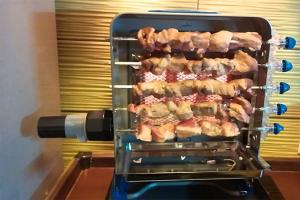(or as we are used to calling them Daylight lamp) are ignited by a discharge created inside the flask.
If anyone is interested in learning about the structure of such a lamp - about their advantages and disadvantages, then you can look into.
In order to obtain a high-voltage discharge, special devices are used - ballast chokes controlled by a starter.
It works something like this: inside the lamp fittings there is a choke and a capacitor that form an oscillating circuit. A starter neon lamp with a small capacitor is installed in series with this circuit. When current passes through a neon lamp, an electrical breakdown occurs in it, the resistance of the lamp drops almost to zero, but it almost immediately begins to discharge through the capacitor. Thus, the starter opens and closes chaotically and chaotic oscillations occur in the throttle.
Due to the EMF of self-induction, these oscillations can have an amplitude of up to 1000 Volts, and they serve as a source of high-voltage pulses that light the lamp.
This design has been used in everyday life for many years and has a number of disadvantages - indefinite switching time, wear of lamp filaments and a huge level of radio interference.
As practice shows, in starter devices (a simplified diagram of one of them is shown in Fig. 1), the sections of the filaments to which the mains voltage is supplied are subject to the greatest heating. This is where the thread often burns out.

More promising - without starter ignition devices, where the filaments are not used for their intended purpose, but act as electrodes of a gas-discharge lamp - they are supplied with the voltage necessary to ignite the gas in the lamp.

Here, for example, is a device designed to power a lamp with a power of up to 40 W (Fig. 2). It works like this. The mains voltage is supplied through inductor L1 to the bridge rectifier VD3. During one of the half-cycles of the mains voltage, capacitor C2 is charged through the zener diode VD1, and capacitor S3 is charged through the zener diode VD2. During the next half-cycle, the mains voltage is summed with the voltage on these capacitors, as a result of which the EL1 lamp lights up. After this, these capacitors are quickly discharged through the zener diodes and diodes of the bridge and subsequently do not affect the operation of the device, since they are not able to charge - after all, the amplitude voltage of the network is less than the total stabilization voltage of the zener diodes and the voltage drop across the lamp.
Resistor R1 removes the residual voltage on the lamp electrodes after turning off the device, which is necessary for safe replacement of the lamp. Capacitor C1 compensates for reactive power.

In this and subsequent devices, pairs of contacts of the connector of each filament can be connected together and connected to “their” circuit - then even a lamp with burnt-out filaments will work in the lamp.
A diagram of another version of the device, designed to power a fluorescent lamp with a power of more than 40 W, is shown in Fig. 3. Here the bridge rectifier is made using diodes VD1-VD4. And the “starting” capacitors C2, C3 are charged through thermistors R1, R2 with a positive temperature coefficient of resistance. Moreover, in one half-cycle, capacitor C2 is charged (through thermistor R1 and diode VD3), and in the other - SZ (through thermistor R2 and diode VD4). Thermistors limit the charging current of the capacitors. Since the capacitors are connected in series, the voltage across lamp EL1 is sufficient to ignite it.
If the thermistors are in thermal contact with the bridge diodes, their resistance will increase when the diodes heat up, which will reduce the charging current.

The inductor, which serves as a ballast resistance, is not necessary in the power devices under consideration and can be replaced with an incandescent lamp, as shown in Fig. 4. When the device is turned on, the lamp EL1 and thermistor R1 heat up. The alternating voltage at the input of the diode bridge VD3 increases. Capacitors C1 and C2 are charged through resistors R2, R3. When the total voltage across them reaches the ignition voltage of lamp EL2, the capacitors will quickly discharge - this is facilitated by diodes VD1, VD2.
By supplementing a conventional incandescent lamp with this device with a fluorescent lamp, you can improve general or local lighting. For a EL2 lamp with a power of 20 W, EL1 should be 75 or 100 W, but if EL2 is used with a power of 80 W, EL1 should be 200 or 250 W. In the latter option, it is permissible to remove the charge-discharge circuits from resistors R2, R3 and diodes VD1, VD2 from the device.

A slightly better option for powering a powerful fluorescent lamp is to use a device with quadrupling the rectified voltage, the diagram of which is shown in Fig. 5. Some improvement of the device that increases the reliability of its operation can be considered the addition of a thermistor connected parallel to the input of the diode bridge (between points 1, 2 of node U1). It will provide a smoother increase in voltage on the parts of the rectifier-multiplier, as well as damping the oscillatory process in a system containing reactive elements (inductor and capacitors), and therefore reducing interference entering the network.
The devices considered use diode bridges KTs405A or KTs402A, as well as rectifier diodes KD243G-KD243Zh or others, designed for a current of up to 1 A and a reverse voltage of 400 V. Each zener diode can be replaced by several in series connected with a lower stabilization voltage. It is advisable to use a non-polar MBGCh type capacitor that shunts the network; the remaining capacitors are MBM, K42U-2, K73-16. It is recommended to bridge the capacitors with resistors with a resistance of 1 MOhm and a power of 0.5 W. The choke must correspond to the power of the fluorescent lamp used (1UBI20 - for a lamp with a power of 20 W, 1UBI40 - 40 W, 1UBI80-80W). Instead of one 40 W lamp, it is permissible to switch on two 20 W lamps in series.
Some of the assembly parts are mounted on a board made of one-sided foil fiberglass, on which areas are left for soldering the leads of the parts and connecting petals for connecting the assembly to the luminaire circuits. After installing the unit into a housing of suitable dimensions, it is filled with epoxy compound.
Fluorescent lamps from the very first releases and are partially still lit using electromagnetic ballasts - EMP. The classic version of the lamp is made in the form of a sealed glass tube with pins at the ends.
What do fluorescent lamps look like?
Inside it is filled with an inert gas with mercury vapor. It is installed in cartridges through which voltage is supplied to the electrodes. An electric discharge is created between them, causing an ultraviolet glow, which acts on the phosphor layer applied to the inner surface of the glass tube. The result is a bright glow. The switching circuit for fluorescent lamps (LL) is provided by two main elements: electromagnetic ballast L1 and glow discharge lamp SF1.

LL connection diagram with electromagnetic choke and starter
Ignition circuits with electronic ballasts
A device with a throttle and starter works according to the following principle:
- Supplying voltage to the electrodes. The current does not pass through the gaseous medium of the lamp at first due to its high resistance. It enters through the starter (St) (Fig. below), in which a glow discharge is formed. In this case, a current passes through the spirals of the electrodes (2) and begins to heat them up.
- The starter contacts heat up, and one of them closes, since it is made of bimetal. The current passes through them and the discharge stops.
- The starter contacts stop heating up, and after cooling, the bimetallic contact opens again. A voltage pulse occurs in the inductor (D) due to self-induction, which is sufficient to ignite the LL.
- A current passes through the gaseous medium of the lamp; after starting the lamp, it decreases along with the voltage drop across the inductor. The starter remains disconnected, since this current is not enough to start it.

Fluorescent lamp connection diagram
Capacitors (C 1) and (C 2) in the circuit are designed to reduce the level of interference. A capacitance (C 1) connected in parallel to the lamp helps reduce the amplitude of the voltage pulse and increase its duration. As a result, the service life of the starter and LL increases. The capacitor (C 2) at the input provides a significant reduction in the reactive component of the load (cos φ increases from 0.6 to 0.9).
If you know how to connect a fluorescent lamp with burnt-out filaments, it can be used in an electronic ballast circuit after a slight modification of the circuit itself. To do this, the spirals are short-circuited and a capacitor is connected in series to the starter. According to this scheme, the light source will be able to work for some more time.
A widely used switching method is with one choke and two fluorescent lamps.

Switching on two fluorescent lamps with a common choke
2 lamps are connected in series between each other and the choke. Each of them requires the installation of a parallel connected starter. To do this, use one output pin at the ends of the lamp.
For LLs, it is necessary to use special switches so that their contacts do not stick due to high inrush current.
Ignition without electromagnetic ballast
To extend the life of burnt-out fluorescent lamps, you can install one of the switching circuits without a choke and starter. For this purpose, voltage multipliers are used.

Diagram for switching on fluorescent lamps without a choke
The filaments are short-circuited and voltage is applied to the circuit. After straightening, it increases 2 times, and this is enough for the lamp to light up. Capacitors (C 1), (C 2) are selected for a voltage of 600 V, and (C 3), (C 4) - for a voltage of 1000 V.
The method is also suitable for working LLs, but they should not operate with DC power. After some time, mercury accumulates around one of the electrodes, and the brightness of the glow decreases. To restore it, you need to turn the lamp over, thereby changing the polarity.
Connection without starter
Using a starter increases the heating time of the lamp. However, its service life is short. Electrodes can be heated without it if secondary transformer windings are installed for this purpose.

Connection diagram for a fluorescent lamp without a starter
Where the starter is not used, the lamp has a quick start designation - RS. If you install such a lamp with a starter, its coils can quickly burn out, since they have a longer warm-up time.
Electronic ballast
Electronic ballast control circuitry has replaced older daylight sources to eliminate their inherent shortcomings. Electromagnetic ballast consumes excess energy, often makes noise, breaks down and damages the lamp. In addition, the lamps flicker due to the low frequency of the supply voltage.
Electronic ballasts are an electronic unit that takes up little space. Fluorescent lamps are easy and quick to start, without creating noise and providing uniform illumination. The circuit provides several ways to protect the lamp, which increases its service life and makes its operation safer.
The electronic ballast works as follows:
- Warming up the LL electrodes. Start-up is quick and smooth, which increases lamp life.
- Ignition is the generation of a high voltage pulse that pierces the gas in the flask.
- Combustion is the maintenance of a small voltage on the lamp electrodes, which is sufficient for a stable process.

Electronic throttle circuit
First, the alternating voltage is rectified using a diode bridge and smoothed by a capacitor (C 2). Next, a half-bridge high-frequency voltage generator using two transistors is installed. The load is a toroidal transformer with windings (W1), (W2), (W3), two of them are connected in antiphase. They alternately open the transistor switches. The third winding (W3) supplies resonant voltage to the LL.
A capacitor (C 4) is connected in parallel to the lamp. Resonant voltage is supplied to the electrodes and penetrates the gaseous environment. By this time the filaments have already warmed up. Once ignited, the lamp's resistance drops sharply, causing the voltage to drop sufficiently to maintain combustion. The startup process lasts less than 1 second.
Electronic circuits have the following advantages:
- start with any specified time delay;
- installation of a starter and a massive throttle is not required;
- the lamp does not blink or hum;
- high-quality light output;
- compactness of the device.
The use of electronic ballasts makes it possible to install it in the base of a lamp, which is also reduced to the size of an incandescent lamp. This gave rise to new energy-saving lamps that can be screwed into a regular standard socket.
During operation, fluorescent lamps age and require an increase in operating voltage. In the electronic ballast circuit, the ignition voltage of the glow discharge at the starter decreases. In this case, its electrodes may open, which will trigger the starter and turn off the LL. Then it starts again. Such blinking of the lamp leads to its failure along with the inductor. In an electronic ballast circuit, a similar phenomenon does not occur, since the electronic ballast automatically adjusts to changes in the parameters of the lamp, selecting a favorable mode for it.
Lamp repair. Video
Tips for repairing a fluorescent lamp can be obtained from this video.
LL devices and their connection circuits are constantly being developed in the direction of improving technical characteristics. It is important to be able to choose suitable models and use them correctly.
Widely used fluorescent lamps are not without drawbacks: during their operation, the buzzing of the choke can be heard, the power system has a starter that is unreliable in operation, and most importantly, the lamp has a filament that can burn out, which is why the lamp has to be replaced with a new one.
The fluorescent lamp becomes “eternal”
Shown here is a diagram that eliminates these shortcomings. There is no usual buzzing, the lamp lights up instantly, there is no unreliable starter, and, most importantly, you can use a lamp with a burnt-out filament. 
Capacitors C1, C4 must be paper, with an operating voltage of 1.5 times the supply voltage. It is advisable for capacitors C2, C3 to be mica.
Resistor R1 is necessarily a wire-wound one; its resistance depends on the power of the lamp.
Data for circuit elements depending on the power of fluorescent lamps are given in the table:
Diodes D2, D3 and capacitors C1, C4 represent a full-wave rectifier with doubling the voltage. The values of capacitances C1, C4 determine the operating voltage of lamp L1 (the larger the capacitance, the greater the voltage on the electrodes of lamp L1). At the moment of switching on, the voltage at points a and b reaches 600 V, which is applied to the electrodes of lamp L1. At the moment of ignition of lamp L1, the voltage at points a and b decreases and ensures normal operation of lamp L1, designed for a voltage of 220 V.
The use of diodes D1, D4 and capacitors C2, C3 increases the voltage to 900 V, which ensures reliable ignition of lamp L1 at the moment of switching on. Capacitors C2, C3 simultaneously help suppress radio interference.
Lamp L1 can work without D1, D4, C2, C3, but in this case the reliability of inclusion decreases.

Since the time the incandescent lamp was invented, people have been looking for ways to create a more economical, and at the same time without loss of luminous flux, electrical appliance. And one of these devices was the fluorescent lamp. At one time, such lamps became a breakthrough in electrical engineering, the same as LED lamps in our time. People thought that such a lamp would last forever, but they were wrong.
Nevertheless, their service life was still significantly longer than simple “Ilyich light bulbs,” which, coupled with efficiency, helped to win more and more consumer confidence. It is difficult to find at least one office space where there would be no fluorescent lamps. Of course, this lighting device is not as easy to connect as its predecessors; the power supply circuit for fluorescent lamps is much more complex, and it is not as economical as LED lamps, but to this day it remains a leader in enterprises and office spaces.
Connection nuances
Schemes for switching on fluorescent lamps imply the presence of an electromagnetic ballast or choke (which is a kind of stabilizer) with a starter. Of course, nowadays there are fluorescent lamps without a choke and starter, and even devices with improved color rendering (LDR), but more on them later.
So, the starter performs the following task: it provides a short circuit in the circuit, heating the electrodes, thereby providing a breakdown, which facilitates ignition of the lamp. After the electrodes have warmed up sufficiently, the starter breaks the circuit. And the inductor limits the current during a circuit, provides a high-voltage discharge for breakdown, igniting and maintaining a stable burning of the lamp after starting.
Operating principle
As already mentioned, the power supply circuit for a fluorescent lamp is fundamentally different from the connection of incandescent devices. The fact is that electricity here is converted into a light flux by flowing current through a accumulation of mercury vapor, which is mixed with inert gases inside the flask. A breakdown of this gas occurs using high voltage supplied to the electrodes.
How this happens can be understood using the example of a diagram.
On it you can see:
- ballast (stabilizer);
- a lamp tube including electrodes, gas and phosphor;
- phosphor layer;
- starter contacts;
- starter electrodes;
- starter housing cylinder;
- bimetal plate;
- filling the flask with inert gas;
- filaments;
- ultraviolet radiation;
- breakdown.
A layer of phosphor is applied to the inner wall of the lamp in order to convert ultraviolet light, which is invisible to humans, into illumination received by normal vision. By changing the composition of this layer, you can change the shade of the color of the lighting fixture.
General information about fluorescent lamps
The color shade of a fluorescent lamp, like an LED lamp, depends on the color temperature. At t = 4,200 K, the light from the device will be white, and it will be marked as LB. If t = 6,500 K, then the lighting takes on a slightly bluish tint and becomes colder. Then the marking indicates that this is an LD lamp, i.e. “daylight”. An interesting fact is that research has revealed that lamps with a warmer shade have a higher efficiency, although to the eye it seems that cool colors shine a little brighter.
And one more point regarding sizes. People call a 30 W T8 fluorescent lamp an “eighty”, implying that its length is 80 cm, which is not true. The actual length is 890mm, which is 9cm longer. In general, the most popular LLs are the T8. Their power depends on the length of the tube:
- T8 at 36 W has a length of 120 cm;
- T8 at 30 W – 89 cm (“eighty”);
- T8 at 18 W – 59 cm (“sixty”);
- T8 at 15 W – 44 cm (“magpie”).
Connection options
Throttleless activation

To briefly prolong the operation of a burnt-out light fixture, there is an option in which it is possible to connect a fluorescent lamp without a choke and starter (connection diagram in the figure). It involves the use of voltage multipliers.
Voltage is supplied after a short circuit of the filaments. The rectified voltage doubles, which is quite enough to start the lamp. C1 and C2 (in the diagram) must be selected for 600 V, and C3 and C4 - for a voltage of 1,000 V. After some time, mercury vapor settles in the area of one of the electrodes, as a result of which the light from the lamp becomes less bright. This can be treated by changing the polarity, i.e. you just need to deploy the reanimated burnt-out LL.
Connecting fluorescent lamps without a starter
The purpose of this element, which provides power to fluorescent lamps, is to increase the heating time. But the starter’s durability is short, it often burns out, and therefore it makes sense to consider the possibility of how to turn on a fluorescent lamp without it. This requires the installation of secondary transformer windings.
There are LDS that are initially designed for connection without a starter. Such lamps are marked RS. When installing such a device in a lamp equipped with this element, the lamp burns quickly. This happens due to the need for more time to warm up the spirals of such LLs. If you remember this information, then the question will no longer arise of how to light a fluorescent lamp if the throttle or starter burns out (connection diagram below).
 Scheme of starterless LDS connection
Scheme of starterless LDS connection
Electronic ballast
The electronic ballast in the LL power supply circuit replaced the outdated electromagnetic ballast, improving the start-up and adding human comfort. The fact is that older starters consumed more energy, often hummed, failed and damaged the lamps. In addition, flicker was present in the work due to low voltage frequencies. With the help of an electronic ballast, we managed to get rid of these troubles. It is necessary to understand how electronic ballasts work.

First, the current passing through the diode bridge is rectified and with the help of C2 (in the diagram below) the voltage is smoothed out. The transformer windings (W1, W2, W3), connected out of phase, load the generator with high-frequency voltage installed after the capacitor (C2). Capacitor C4 is connected in parallel to the LL. When a resonant voltage is applied, a breakdown of the gaseous medium occurs. The filament is already warmed up at this time.
After ignition is completed, the lamp resistance readings decrease, and along with them the voltage drops to a level sufficient to maintain the glow. The entire startup work of the electronic ballast takes less than a second. Fluorescent lamps work according to this scheme without a starter.
Design features, and with them the switching circuit of fluorescent lamps, are constantly updated, changing for the better in energy savings, decreasing in size and increasing in durability. The main thing is proper operation and the ability to understand the huge range offered by the manufacturer. And then LL will not leave the electrical engineering market for a long time.
When choosing a modern method of lighting a room, you need to know how to connect a fluorescent lamp yourself.
The large surface area of the glow helps to obtain even and diffuse illumination.
Therefore, this option has become very popular and in demand in recent years.
Fluorescent lamps belong to gas-discharge lighting sources, characterized by the formation of ultraviolet radiation under the influence of an electrical discharge in mercury vapor with subsequent conversion into high visible light output.
The appearance of light is due to the presence on the inner surface of the lamp of a special substance called phosphor, which absorbs UV radiation. Changing the composition of the phosphor allows you to change the tint range of the glow. The phosphor can be represented by calcium halophosphates and calcium-zinc orthophosphates.

The principle of operation of a fluorescent light bulb
The arc discharge is supported by thermionic emission of electrons on the surface of the cathodes, which are heated by passing a current limited by the ballast.
The disadvantage of fluorescent lamps is represented by the inability to make a direct connection to the electrical network, which is due to the physical nature of the lamp glow.
A significant part of luminaires intended for installation of fluorescent lamps have built-in glow mechanisms or chokes.
Connecting a fluorescent lamp
 To correctly carry out independent connection, you need to choose the right fluorescent lamp.
To correctly carry out independent connection, you need to choose the right fluorescent lamp.
Such products are marked with a three-digit code containing all the information about the quality of light or color rendering index and color temperature.
The first number of the marking indicates the level of color rendering, and the higher these indicators are, the more reliable color rendering can be obtained during the lighting process.
The designation of the lamp glow temperature is represented by digital indicators of the second and third order.
The most widely used is an economical and highly efficient connection based on an electromagnetic ballast, supplemented by a neon starter, as well as a circuit with a standard electronic ballast.
Connection diagrams for a fluorescent lamp with a starter
Connecting an incandescent lamp yourself is quite simple, due to the presence of all the necessary elements and a standard assembly diagram in the kit.
Two tubes and two chokes
 The technology and features of independent serial connection in this way are as follows:
The technology and features of independent serial connection in this way are as follows:
- supply of phase wire to the ballast input;
- connecting the choke output to the first contact group of the lamp;
- connecting the second contact group to the first starter;
- connection from the first starter to the second lamp contact group;
- connecting the free contact to the wire to zero.
The second tube is connected in a similar way. The ballast is connected to the first lamp contact, after which the second contact from this group goes to the second starter. Then the starter output is connected to the second lamp pair of contacts and the free contact group is connected to the neutral input wire.
This connection method, according to experts, is optimal if there are a pair of lighting sources and a pair of connecting kits.
Connection diagram for two lamps from one choke
Independent connection from one choke is a less common, but completely uncomplicated option. This two-lamp series connection is economical and requires the purchase of an induction choke, as well as a pair of starters:
- a starter is connected to the lamps through a parallel connection to the pin output at the ends;
- sequential connection of free contacts to the electrical network using a choke;
- connecting capacitors in parallel to the contact group of the lighting device.

Two lamps and one choke
Standard switches belonging to the category of budget models are often characterized by sticking contacts as a result of increased starting currents, so it is advisable to use special high-quality versions of contact switching devices.
How to connect a fluorescent lamp without a choke?
Let's look at how fluorescent fluorescent lamps are connected. The simplest chokeless connection scheme is used even on burnt-out fluorescent lamp tubes and is distinguished by the absence of the use of an incandescent filament.
In this case, the power supply to the lighting device tube is due to the presence of an increased DC voltage through a diode bridge.

Switching on a lamp without a choke
This circuit is characterized by the presence of a conductive wire or a wide strip of foil paper, one side connected to the terminal of the lamp electrodes. For fixation at the ends of the bulb, metal clamps of the same diameter as the lamp are used.
Electronic ballast
The operating principle of a lighting fixture with electronic ballast is that electric current passes through a rectifier and then enters the buffer zone of the capacitor.
In electronic ballast, along with classic starting control devices, starting and stabilization occurs through a throttle. Power depends on high frequency current.

Electronic ballast
The natural complexity of the circuit is accompanied by a number of advantages compared to the low-frequency version:
- increasing efficiency indicators;
- elimination of flickering effect;
- reduction in weight and dimensions;
- absence of noise during operation;
- increasing reliability;
- long service life.
In any case, one should take into account the fact that electronic ballasts belong to the category of pulsed devices, so turning them on without sufficient load is the main cause of failure.
Checking the performance of an energy-saving lamp
Simple testing allows you to timely identify a breakdown and correctly determine the main cause of the malfunction, and sometimes even perform the simplest repair work yourself:

- Dismantling the diffuser and carefully examining the fluorescent tube in order to detect areas of pronounced blackening. Very rapid blackening of the ends of the flask indicates burnout of the spiral.
- Checking the filaments for breaks using a standard multimeter. If there is no damage to the threads, the resistance values can vary within 9.5-9.2Om.
If checking the lamp does not show malfunctions, then the lack of operation may be due to the breakdown of additional elements, including the electronic ballast and the contact group, which quite often undergoes oxidation and needs to be cleaned.
Checking the performance of the throttle is carried out by disconnecting the starter and shorting it to the cartridge. After this, you need to short-circuit the lamp sockets and measure the throttle resistance. If replacing the starter fails to achieve the desired result, then the main fault, as a rule, lies in the capacitor.
What causes danger in an energy-saving lamp?
Various energy-saving lighting devices, which have recently become very popular and fashionable, according to some scientists, can cause quite serious harm not only to the environment, but also to human health:- poisoning with mercury-containing vapors;
- lesions of the skin with the formation of a severe allergic reaction;
- increased risk of developing malignant tumors.
Flickering lamps often cause insomnia, chronic fatigue, decreased immunity and the development of neurotic conditions.
It is important to know that mercury is released from a broken fluorescent lamp bulb, so operation and further disposal must be carried out in compliance with all rules and precautions.
A significant reduction in the service life of a fluorescent lamp, as a rule, is caused by voltage instability or malfunctions of the ballast resistance, therefore, if the electrical network is of insufficient quality, it is suggested to use conventional incandescent lamps.
Video on the topic








